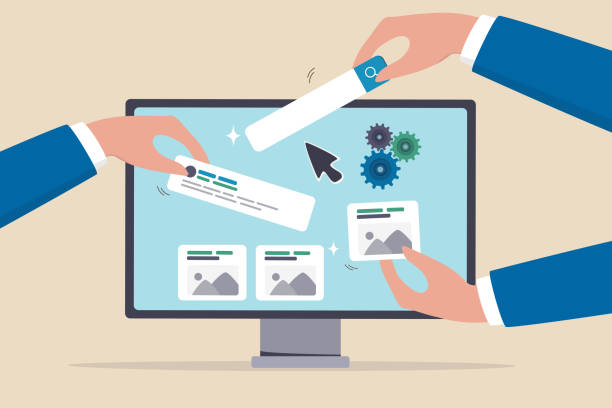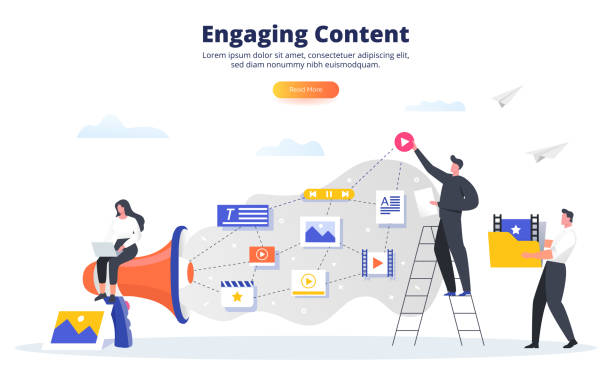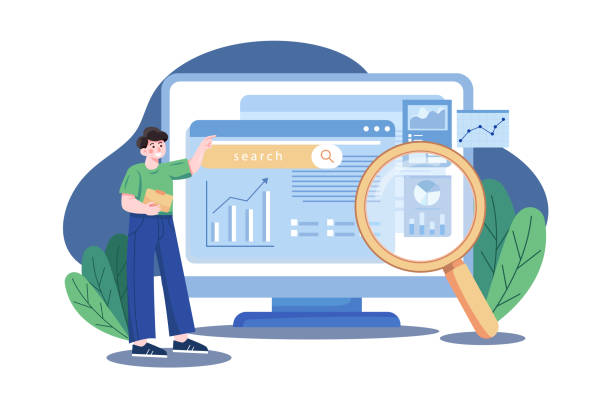An Introduction to the Importance of Modern UI Website Design

In today’s digital world, where competition for user attention is fiercer than ever, merely having a website is not enough.
Instead, the website must be designed to offer an excellent user experience and easily connect with its audience.
This is where the concept of #Modern_User_Interface_Design (UI) and #User_Experience (UX) truly demonstrates its significance.
User Interface refers to everything a user interacts with, from buttons and menus to images and fonts.
However, user experience goes beyond appearance; this concept encompasses the user’s overall feeling when using a product or service, from entry to exit.
In other words, UI deals with the aesthetics and presentation of the product, while UX focuses on its efficiency and ease of use.
A #Modern_Website cannot succeed without simultaneously addressing both these aspects.
Designing a website with a modern user interface is no longer a competitive advantage, but an absolute necessity for any business that wants to make its mark in the online space.
Today’s users have high expectations; they seek websites that load quickly, are visually appealing, easy to navigate, and offer consistent performance across all devices (mobile, tablet, desktop).
Neglecting these aspects can lead to losing visitors, decreasing conversion rates, and ultimately harming brand reputation.
By investing in modern user interface design, businesses can build trust and loyalty with their users.
This means designing websites that are not only beautiful but also intuitively usable and anticipate user needs.
An excellent user interface can increase time spent on the site, reduce the bounce rate, and ultimately, directly impact sales and revenue.
Furthermore, a website with a modern design also helps improve SEO, as search engines rank websites that offer a better user experience higher.
This evolution in web design approach emphasizes the truth that your website is not just a storefront, but a powerful tool for interaction and customer conversion.
Does your company’s website perform as it deserves for your brand? In today’s competitive world, your website is your most important online tool. Rasaweb, specialists in professional corporate website design, helps you to:
✅ Build customer credibility and trust
✅ Convert website visitors into customers
⚡ Get a free consultation!
Key Principles of Modern UI Design for Websites

To achieve a truly modern and user-friendly website with a modern user interface, adherence to specific principles is essential.
These principles not only contribute to the aesthetic appeal of the website but also enhance its efficiency and effectiveness.
The first and perhaps most important principle is #Simplicity and minimalism.
This means eliminating unnecessary elements and focusing on the core content.
A simple design reduces visual clutter and helps users find the information they need more quickly.
This approach involves the smart use of whitespace to create balance and better readability.
The second principle is #Visual_harmony and consistency.
All design elements, including fonts, colors, icons, and images, must be consistent and harmonious throughout the website.
This consistency conveys a sense of professionalism and credibility to the user and makes navigation more intuitive.
Using a Style Guide can help maintain this consistency.
The next principle is intuitive and predictable navigation.
Users should be able to find their way around the website without having to think too much.
This includes using clear menus, recognizable links, and a logical page structure.
Modern website design with a modern user interface also emphasizes #Instant_feedback.
When a user interacts with an interactive element such as a button or form, they should receive visual or textual feedback indicating whether their action was successful or requires attention.
This feedback can take the form of a button color change, a confirmation message, or small animations that improve the user experience.
Usability and Accessibility are also core pillars of modern design.
A website must be usable for all users, including those with specific disabilities.
This includes providing alternative text for images, appropriate color contrast, and keyboard navigation support.
Finally, Performance is also a key principle.
A website with a modern user interface must load quickly and be responsive without delay.
Long loading times can quickly frustrate users and lead to site abandonment.
Optimizing images, using clean and efficient code, and utilizing Content Delivery Networks (CDNs) are among the measures that help improve performance.
By adhering to these principles, it is possible to create websites that are not only beautiful but also provide a flawless user experience and contribute to business goals.
This approach ensures that your website will be a powerful tool in the hands of users.
Tools and Techniques for Implementing Modern UI Website Design

Implementing modern UI website design requires knowledge and the use of a set of #design_tools and frontend development techniques.
Today’s UI/UX designers use powerful software for design and prototyping.
Tools like Figma, Sketch, and Adobe XD are leaders in this field.
Figma has become very popular due to its cloud collaboration capabilities and real-time team work.
Sketch is recognized as an industry standard for Mac-based UI design, while Adobe XD offers a comprehensive solution for design and prototyping within the Adobe ecosystem.
These tools enable the design of wireframes, mockups, and interactive prototypes, helping designers test and validate their ideas before actual coding.
In the frontend development sector, JavaScript and its #frameworks and libraries play a pivotal role.
Frameworks such as React.js, Vue.js, and Angular allow developers to create complex and dynamic user interfaces in a component-based and high-performance manner.
React.js, developed by Facebook, is popular for its component-based approach and Virtual DOM for building fast and scalable user interfaces.
Vue.js is also an excellent choice for small to medium, and even large projects, due to its simplicity and easy learning curve.
Angular, supported by Google, is a comprehensive and powerful framework for building large Single-Page Applications (SPAs).
Table 1: Comparison of UI Design Tools and Frontend Frameworks
| Feature | Figma (Design Tool) | React.js (Frontend Framework) | Vue.js (Frontend Framework) |
|---|---|---|---|
| Tool Type | Design & Prototyping | User Interface Building | User Interface Building |
| Main Application | UI Design, Team Collaboration | Building SPAs & Complex Web Applications | Rapid Web Application Development |
| Advantages | Cloud collaboration, numerous plugins, free to start | High performance (Virtual DOM), large community, component-based | Easy to learn, good performance, lightweight & flexible |
| Potential Disadvantages | Requires internet, high resource consumption for large files | Relatively steep learning curve, complexity for small projects | Slightly smaller community compared to React/Angular |
| Common Use | Design teams, startups, freelancers | Large companies, high-scale projects | Medium projects, new developers |
Also, #frontend_techniques such as CSS-in-JS (like Styled Components), the use of Design Systems, and UI component libraries (like Material-UI or Ant Design) play a significant role in accelerating and integrating development.
These techniques and tools enable developers to create appealing, responsive, and modern UI websites with greater efficiency and speed, ultimately delivering a flawless user experience.
A deep understanding of these tools and techniques is crucial for any team aiming for the successful implementation of a modern UI website design.
The Impact of Modern User Interface on User Engagement and Conversion Rate

One of the most important reasons for investing in modern UI website design is its direct impact on #user_engagement and ultimately on the #conversion_rate.
An appealing and intuitive user interface encourages users to spend more time on the website, view more pages, and engage more with your content.
When a website is easily navigable and information is presented visually and organized, users feel less confused and are more inclined to achieve their goals (such as making a purchase, signing up, or downloading content).
This increased engagement is a fundamental prerequisite for improving the conversion rate.
Numerous studies have shown that poorly designed websites have significantly higher bounce rates.
This means that users leave the site after viewing only one page.
In contrast, a modern and optimized design dramatically reduces the bounce rate.
When users have a positive experience interacting with the website, they not only stay longer but also are more likely to return.
These returns, over time, contribute to building brand loyalty and repeat online purchases.
This positive impact directly affects the #ROI (Return on Investment) of web design investment.
Conversion rate, which is the measure of a website’s success in converting visitors into customers or leads, is heavily influenced by user interface design.
A well-designed Call-to-Action button, strategic placement of important elements, simple and understandable forms, and frictionless payment processes are all components of a modern user interface that directly impact the conversion rate.
For example, designing a registration form that asks only for essential information and is completed in several small steps can significantly increase the form completion rate.
Furthermore, a modern user interface allows businesses to meticulously examine user behavior through A/B testing and data analysis, and based on that, implement continuous improvements.
This data-driven approach ensures that website design is always on the optimal path and is constantly refined to maximize engagement and conversion.
Ultimately, investing in a modern user interface is an investment in business growth, as a superior user experience directly leads to better financial results.
Does your current site reflect your brand’s credibility as it should? Or is it driving away potential customers?
Rasaweb, with years of experience in professional corporate website design, is your comprehensive solution.
✅ A modern, beautiful website tailored to your brand identity
✅ Significant increase in lead generation and new customers
⚡ Contact Rasaweb now for a free corporate website design consultation!
Responsive Design and Mobile-First Approach in Modern UI

In the current era, where mobile device usage for internet access has surpassed desktop, the #responsive_design and #mobile_first approach is not merely an option, but a vital necessity in modern UI website design.
Responsive design means designing a website that can automatically adapt its layout, image sizes, and other elements to the screen size of the device the user is employing.
This adaptability ensures that your website has a beautiful appearance and flawless performance on any device, from small smartphones to large desktop monitors and tablets.
The Mobile-First approach goes a step further.
Instead of designing for desktop first and then adapting it for mobile, this approach begins with designing for the smallest screen (usually mobile) first.
After complete design and optimization for mobile, the design is then expanded and improved for larger devices like tablets and desktops.
The reason for this approach is that designing for the constraints of smaller screens forces the design team to focus on core content and essential functionalities.
This helps eliminate unnecessary elements and create a more focused and efficient user experience.
The importance of #compatibility in today’s website design can be examined from two perspectives.
First, from the user’s perspective, a non-responsive website on mobile provides a frustrating and difficult experience.
The need to zoom, horizontal scrolling, or small, un-tappable buttons quickly drives users away from the site.
Second, from an SEO perspective, search engines like Google prioritize websites that are optimized for mobile.
Google has explicitly stated its adoption of mobile-first indexing, meaning that the mobile version of your website will be the primary basis for its ranking.
For effective implementation of these approaches, designers and developers must utilize CSS techniques like Flexbox and Grid for structuring layouts, employ relative units (such as percentages and em/rem) for sizing elements, and optimize images for various devices (such as using responsive images).
Furthermore, continuous testing of the website on different devices and screen sizes is essential to ensure correct functionality and a unified user experience.
In summary, responsive and mobile-first design is the cornerstone of any modern web design and is crucial for success in today’s online space.
Accessibility and Inclusivity in Modern Web Design

Alongside aesthetics and functionality, one of the crucial and often overlooked dimensions in modern UI website design is the topic of #Accessibility and #Inclusive_Design.
Accessibility means that your website should be usable for all individuals, regardless of physical or mental abilities, technical limitations (such as slow internet speed or older devices), or environmental conditions (such as strong sunlight or a noisy environment).
This is an ethical responsibility and, in many countries, a legal requirement.
Ignoring accessibility not only excludes a portion of your audience but can also lead to legal issues and harm to brand reputation.
WCAG standards (Web Content Accessibility Guidelines), published by the World Wide Web Consortium (W3C), provide comprehensive guidelines for creating accessible web content.
These guidelines have four basic principles: Perceivable, Operable, Understandable, and Robust.
For example, ensuring that images have alternative text (alt text) for visually impaired users, using appropriate color contrast for individuals with low vision, enabling full website navigation using only a keyboard for users who cannot use a mouse, and providing captions or transcripts for audio and video content are all aspects addressed in WCAG.
Inclusive design goes a step beyond accessibility, meaning designing products that, from the outset, consider a wide range of users with diverse needs and abilities.
This approach involves a deeper understanding of human diversity and designing solutions that are effective for everyone.
For example, considering users with reading disabilities like dyslexia by using readable fonts and simple layouts, or users with motor impairments who use assistive technologies.
Implementing accessibility and inclusive design is not only ethically correct but also has business benefits.
Accessible websites typically have cleaner and more optimized code, which aids SEO.
Also, by expanding your audience, you can reach a larger target market and access groups of users who were previously overlooked.
Training design and development teams, using accessibility testing tools, and conducting user tests with individuals with disabilities are important steps in ensuring the accessibility of a modern website.
This approach places sustainability and responsibility at the heart of modern UI website design.
Future Trends in Web User Interface and User Experience Design

The world of User Interface and User Experience (UI/UX) design is rapidly evolving, and every year we witness the emergence of new trends that transform how we interact with websites.
Modern UI website design is also constantly influenced by these changes.
One of the most important future trends is the integration of Artificial Intelligence (AI) into design processes and user experience.
#AI_in_Design can help personalize content based on user behavior, automate layout optimization, and even automatically generate UI elements.
Smart chatbots and Voice User Interfaces (Voice UI) are also increasingly becoming part of the web experience, allowing for more natural interaction with websites.
Another trend is the emergence of #Virtual_Reality (VR) and #Augmented_Reality (AR) in web design.
Although these technologies are still in their early stages for the web, they hold great potential for creating immersive and three-dimensional experiences.
Future websites may allow users to try products in a virtual environment or explore 3D spaces.
This evolution requires new design approaches that can handle 3D dimensions and interactions.
Furthermore, Motion Design and Micro-interactions will also move towards greater complexity and subtlety.
These small but powerful elements improve visual feedback and make the user experience more enjoyable.
Table 2: Emerging Trends in Web UI/UX
| Trend | Brief Description | Impact on User Experience | Challenges |
|---|---|---|---|
| AI-Powered Design | Using AI for personalization, optimization, and even generation of UI elements | More personalized UX, high design efficiency | Need for big data, ethical issues, preserving human creativity |
| Voice User Interface (VUI) | Ability to interact with the website via voice commands | Improved accessibility, more natural hands-free user experience | Accurate speech recognition, natural language processing, privacy |
| Augmented/Virtual Reality (AR/VR) on Web | Integration of AR/VR elements for immersive browser experiences | More realistic product experience, innovative interactions, greater entertainment | Need for specific hardware, performance optimization, development complexity |
| Micro-interactions (Advanced Micro-interactions) | Small and subtle animations and feedback to improve daily interactions | More delightful feeling, better understanding of system functionality, aesthetics | Implementation complexity, avoiding excess, performance optimization |
| Dark Mode | Providing an option to display the UI in a dark color palette | Reduced eye strain, battery saving, visual appeal | Proper contrast, ensuring readability in both modes |
Another important trend is the increasing attention to Dark Mode design. Dark Mode is not only visually appealing but can also reduce eye strain and help save device battery life.
These trends indicate that modern UI website design is moving towards more personalization, natural interactions, and immersive experiences.
For designers and developers, readiness to embrace these changes and continuous learning will be the key to future success.
Challenges and Solutions for Implementing Modern User Interface

Implementing modern UI website design, despite its numerous advantages, is not without #design_challenges.
One of the biggest challenges is balancing visual aesthetics with performance and loading speed.
Modern designs often include complex animations, high-quality images, and interactive effects that can increase the website’s file size and loading time.
This can negatively impact the user experience, especially for users with slow internet connections or older devices.
The solution to this challenge involves careful resource optimization, using next-generation image formats (like WebP), and implementing lazy loading techniques for images and videos.
Additionally, using Content Delivery Networks (CDNs) is highly beneficial for improving content delivery speed globally.
Another challenge is #managing_stakeholder_expectations and coordination between design and development teams.
Designers may have creative ideas that are technically complex or expensive to implement.
On the other hand, developers might prefer solutions that are technically easier but may not be optimal from a user experience perspective.
The solution to this challenge is continuous communication and close collaboration between teams from the earliest stages of the project.
Holding joint meetings, using shared tools (like Figma for design and JIRA for project management), and fostering a common understanding of goals and limitations can help facilitate this coordination.
Maintaining #performance_optimization and compatibility across different browsers and diverse devices is also an ongoing challenge. With the myriad of devices and browsers available, ensuring that your website displays correctly and performs well on all of them is difficult.
Thorough and continuous testing in various environments, adhering to web standards, and using modern frameworks that support browser compatibility, are solutions to this challenge.
The final challenge is keeping up with rapidly changing UI/UX trends.
The world of web design is constantly evolving, and what is considered modern today may be obsolete tomorrow.
This requires continuous learning and adaptability.
Investing in team training and skill development, and allocating time for research and experimentation with new technologies and trends, are strategies that help teams stay at the forefront of modern design and deliver an impactful modern UI website design.
Are your online sales not meeting expectations? With Rasaweb, permanently solve the problem of low sales and poor user experience!
✅ Increase visitor-to-customer conversion rate
✅ Create an enjoyable user experience and boost customer trust
⚡ Act now to get a free consultation!
Successful Examples of Modern UI Website Design

To better understand what #modern_UI_website_design can offer, looking at #top_websites and successful examples in this field is very #inspiring.
These websites are not only visually appealing but also provide a flawless user experience that keeps users engaged and satisfied.
One prominent example is the Apple website.
By focusing on minimalism, high-quality images, ample whitespace, and intuitive navigation, Apple has created a very fluid and luxurious user experience.
Their website showcases products in a highly engaging and interactive manner and provides necessary information without visual clutter.
The use of parallax scrolling and subtle animations makes interacting with the site enjoyable.
Another example is the Stripe website, a payment platform for developers.
Stripe’s website, with its clean design, expressive graphics, and explanatory animations, has managed to present a complex technical product in an understandable and engaging way.
Their navigation is clear, and different sections are well-organized, allowing developers to quickly access the documentation and tools they need.
This example shows that even technical products can benefit from a strong modern and visual user interface.
The Airbnb website is also an excellent example of modern UI website design that focuses on a personalized user experience.
This website, by using large, high-quality images of accommodations, advanced search filters, and a simple booking process, makes the travel planning experience very easy and enjoyable.
Their focus on #case_studies in reality, not just visual design, but also understanding user needs and simplifying processes, has made them a leader in their industry.
These websites share common characteristics:
- Focus on simplicity and clarity: Eliminating extra elements and concentrating on core content.
- Use of whitespace: To create visual balance and better readability.
- High-quality images and videos: To attract attention and convey messages quickly.
- Subtle and meaningful animations: For feedback and visual appeal.
- Intuitive and responsive navigation: For easy access to information on any device.
- Personalized experience: Based on user behavior and preferences.
These successful examples demonstrate that modern UI website design is a strategic investment that helps businesses not only attract customers but also retain them for a long time.
How to Start Your Journey in Modern Web Design with a Focus on User Interface?

If you are a business looking to update your website with a modern UI website design, or an individual planning to enter the #UI/UX_design_career_path, there are specific steps you can take.
For businesses, the first step is a thorough assessment of the current website and identifying weaknesses in the user experience.
This includes gathering user feedback, analyzing traffic data, and researching competitors.
Then, defining clear goals for redesign is essential: Are you looking to increase conversion rates? Improve user engagement? Or simply appear more modern?
After defining the goals, collaborating with a specialized team in UI/UX design is highly recommended.
This team can include UI/UX designers, frontend developers, and SEO specialists.
Ensure you choose a team that not only possesses the necessary technical skills but also has a user-centric approach and adheres to accessibility and responsive design principles.
Careful budget and timeline planning for the project is also crucial to avoid any delays or additional costs.
Continuous communication with the design team and providing feedback at various stages of the project helps ensure the desired final outcome.
For individuals interested in #learning_UI/UX_design, there are numerous educational paths.
Starting with learning basic design principles, such as color theory, typography, and visual composition, is essential.
Then, delve into user experience principles, such as information architecture, user research, and testability.
Numerous online resources, including courses from Coursera, Udemy, edX, and specialized websites like NN/g (Nielsen Norman Group) and Smashing Magazine, can help you.
Learning design software such as Figma, Sketch, or Adobe XD is also an important step.
Most importantly, building a strong #portfolio is key.
Even if you don’t have formal work experience, you can showcase your skills by undertaking personal projects, redesigning existing websites, or participating in design challenges.
These projects should demonstrate your thought process in solving user experience problems and your ability to implement appealing visual designs.
Finally, networking with other designers and developers and staying up-to-date with industry trends will assist you on this fast-paced journey.
Embarking on this path, whether for a business or an individual, means investing in a brighter digital future.
Frequently Asked Questions
| Question | Answer |
|---|---|
| What is modern UI website design? | It is an approach that focuses on simplicity, visual appeal, user-friendliness, and utilizing the latest design trends. |
| What are the key principles of modern UI? | Simplicity, clarity, accessibility, responsiveness, and focus on user experience. |
| Why is the use of whitespace (Whitespace) important in modern design? | Whitespace contributes to readability, user focus on content, and creates a sense of order and aesthetics. |
| What is the role of typography in modern UI? | Choosing the right font significantly helps brand identity, text readability, and visual hierarchy. |
| How can colors be effectively used in modern design? | Strategic use of an appropriate color palette to guide the user’s eye, establish brand mood, and improve accessibility. |
| What role do visual elements like icons and images play? | These elements contribute to visual appeal, quick message delivery, and improved user comprehension of content. |
| What is the importance of responsiveness in modern design? | It is essential for the site to have an optimal appearance and correct functionality on all devices such as mobile, tablet, and desktop. |
| How does modern UI help user experience (UX)? | By creating an appealing and user-friendly visual environment, easier navigation, and more enjoyable interaction, the overall user experience is improved. |
| What are some common trends in modern UI? | Dark Mode, Neomorphism, Glassmorphism, subtle animations, and micro-interactions. |
| What steps are needed to achieve a modern UI? | User research, wireframe and prototype design, user testing, and using up-to-date tools and frameworks. |
And other services of Rasaweb Advertising Agency in the field of advertising
Smart Link Building: Professional optimization to increase website traffic by precisely targeting the audience.
Smart SEO: An innovative service to boost online growth through key page optimization.
Smart Social Media: A creative platform to improve customer behavior analysis with custom programming.
Smart Customer Journey Map: A fast and efficient solution to increase website traffic with a focus on SEO-driven content strategy.
Smart Brand Identity: A professional solution for digital branding with a focus on key page optimization.
And more than hundreds of other services in the field of internet advertising, advertising consultation, and organizational solutions
Internet Advertising | Advertising Strategy | Advertorials
Resources
Modern Website Design for Businesses
The Importance of User Experience (UX) in Website Success
Comprehensive Guide to User Interface (UI) Design
How to Transform Your Business with Professional Website Design?
? At Rasaweb Afarin, your dream for a powerful presence in the digital world becomes a reality. We elevate your business to new heights by providing comprehensive digital marketing services, including fast website design and professional optimization.
📍 Tehran, Mirdamad Street, next to Bank Markazi, Kazeroon Jonoubi Alley, Ramin Alley, No. 6




